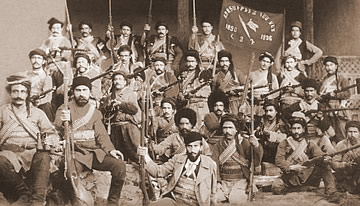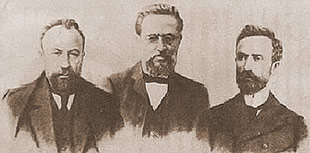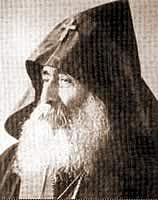From 1820 to 1914
Uprisings in the Ottoman Empire
The 20s and the 30s of the 19th century were marked by several revolts of the non-Turkish peoples throughout the Ottoman Empire. Greece obtained independence in 1829. The Serbs, Bulgarians, Albanians and Armenians were about to throw off the Turkish sway. The fall of the declining Empire seemed inevitable. However, the Turks held on as a result of the European disagreement about how to divide the spheres of influence.
 Portait of Nicolas I, by Franz Krüger, 1852.Once again, Armenians put their hopes on Russia. During the Russo-Turkish war of 1829, the czar Nicholas I captured Erzerum, and advanced toward Constantinople, but was stopped by European powers. Paradoxically, just 3 years later, Russians were involved in a conflict against Egypt in order to protect the Ottoman Sultan. The inconsistent Russian policy resulted in a number of setbacks for Russia’s further expansion. On the other hand, England, Germany and France, though sympathetic toward the enslaved nations of the Ottoman Empire, made reducing the Russian influence their main priority, thus playing into the hands of the Turks.
Portait of Nicolas I, by Franz Krüger, 1852.Once again, Armenians put their hopes on Russia. During the Russo-Turkish war of 1829, the czar Nicholas I captured Erzerum, and advanced toward Constantinople, but was stopped by European powers. Paradoxically, just 3 years later, Russians were involved in a conflict against Egypt in order to protect the Ottoman Sultan. The inconsistent Russian policy resulted in a number of setbacks for Russia’s further expansion. On the other hand, England, Germany and France, though sympathetic toward the enslaved nations of the Ottoman Empire, made reducing the Russian influence their main priority, thus playing into the hands of the Turks.
First Armenian Political Parties
During the next decades, the Turk rulers led the policy of large-scale reforms known as the Tanzimat (Turkish for “reorganization”). The reforms were aimed to “civilize” Turkey making it look a more “European” country. Some 30 years of Tanzimat affected all aspects of political and social life. For the enslaved nations, it marked an unprecedented raise of the national-liberation movement.
 Group of Armenian fedayee (guerilla), photographed around 1890. Text on an Armenian Revolutionary Federation banner reads “Liberty or Death”.The uprisings of Balkan peoples and the plight of Armenians urged the Russian intervention in 1877-1878. After the Treaty of San Stefano Russia gained control over a large part of Armenia and obtained the independence of Romania and Serbia. However, Russia had to step back as a result of the English and German pressure. The Treaty of San Stefano was revised and the Czar Alexander II withdrew the Russian troops from the Armenian territories.
Group of Armenian fedayee (guerilla), photographed around 1890. Text on an Armenian Revolutionary Federation banner reads “Liberty or Death”.The uprisings of Balkan peoples and the plight of Armenians urged the Russian intervention in 1877-1878. After the Treaty of San Stefano Russia gained control over a large part of Armenia and obtained the independence of Romania and Serbia. However, Russia had to step back as a result of the English and German pressure. The Treaty of San Stefano was revised and the Czar Alexander II withdrew the Russian troops from the Armenian territories.
The coming to power of the despotic Sultan Abd al-Hamid II in 1876 put an end to the Tanzimat. Nonetheless, the Armenian liberation movement gathered momentum. The three major Armenian political Parties were founded: Hnchak, Dashnaktsutiun and Ramkavar.
Massacres of Abdul-Hamid
 The young Sultan Abdul-Hamid, photographed in 1867. He is thought to have an Armenian mother, originally named Virgine, one of many wifes of his father Sultan Abdulmecid I.Photo from the United States Library of Congress.From 1894 to 1896, the systematic massacres were organized by Abdul-Hamid in order to punish Armenians for their aspiration for freedom. The Sultan considered the Armenian population as an eternal excuse for Europeans and for Russians to interfere. The government instigated assaults on the Armenian villages, that quickly spread to all regions of Western Armenia.
The young Sultan Abdul-Hamid, photographed in 1867. He is thought to have an Armenian mother, originally named Virgine, one of many wifes of his father Sultan Abdulmecid I.Photo from the United States Library of Congress.From 1894 to 1896, the systematic massacres were organized by Abdul-Hamid in order to punish Armenians for their aspiration for freedom. The Sultan considered the Armenian population as an eternal excuse for Europeans and for Russians to interfere. The government instigated assaults on the Armenian villages, that quickly spread to all regions of Western Armenia.
The armed revolts in several places, particularly in Zeytun, were put down with harsh methods. Over 200 thousand of Armenians were killed as a result of bloody pogroms. Historians named Abdul-Hamid “Red Sultan”.
The Young Turks and massacres in Adana
Meanwhile, the new opposition Party of the Young Turks rose in the Ottoman Empire. Propagating the attractive slogans of “fraternity and common homeland”, the leaders of Young Turks inspired many short-sighted Armenians, who believed in the reality of an “autonomous Western Armenia”. As the Young Turks struggled against the Red Sultan, Armenian parties and leaders assisted them and supported them financially.
After the so-called Young Turk Revolution of 1908, the Sultan’s authority was reduced to the point that he became a sheer symbolic figure. Although an attempt to a counterrevolution was made, the Young Turks managed to retain the real power. Abdul-Hamid, forced to abdicate in 1909 was removed to solitary confinement. He was replaced by Mehmed V, who was only a puppet of the Young Turks. Then, the leaders of the Young Turks founded a new powerful party called Ittihad ve Terakki (Turkish for “Union and Progress”).
The victory of the Young Turks marked the immediate end to the Armenian illusions. In 1909, a series of bloody rampages took place in Adana, Cilicia, where the Turkish mobs were supported by the Turkish army. The sporadic pogroms took place in different cities. Some 35,000 Armenians were killed as a result of these massacres. In despite of the promises and oaths to “establish order”, the threat of the physical extermination of the Armenian nation was imminent.
Andranik
 General Andranik, photographed in Paris, in 1921.In 1912, the Balkan wars began. Serbia, Montenegro, Bulgaria and Greece formed a coalition against the Ottoman Empire. The coalition gained a number of important victories and the Turks sued for peace.
General Andranik, photographed in Paris, in 1921.In 1912, the Balkan wars began. Serbia, Montenegro, Bulgaria and Greece formed a coalition against the Ottoman Empire. The coalition gained a number of important victories and the Turks sued for peace.
An Armenian hero Andranik Toros Ozanian (later known as General Andranik) fought for the Bulgarians forming an Armenian volunteer unit. Bulgarian authorities honored him by the “Cross of Bravery”. Later, Andranik will join the Russian Army and become General of the Armenian units, decorated 6 times for gallantry.
The Armenians on the threshold of destruction
The First Balkan war marked serious territorial losses for the Ottoman Empire, but during the Second War in the next year the Turks regained the large territories as a result of a discord between the Balkan States.
In 1913, a coup d’état within the Union and Progress committee brought an extreme nationalist triumvirate headed by Enver, Talaat and Gemal to the absolute power in the Ottoman Empire. The racist doctrines of Pan-Turkism, Turkish national exclusiveness and Turkish homogeneous state were preached by party’s ideologists, such as Zia, Dr.Nazim and Dr.Shakir. Armenians were openly termed as superfluous and dangerous elements inside the Ottoman Empire. In many places, the Armenian bankers were accused of “looting the country” just like the Armenian intelligentsia was blamed of undermining the state foundations.
The Armenian nation entered the gloomiest period of its history.










